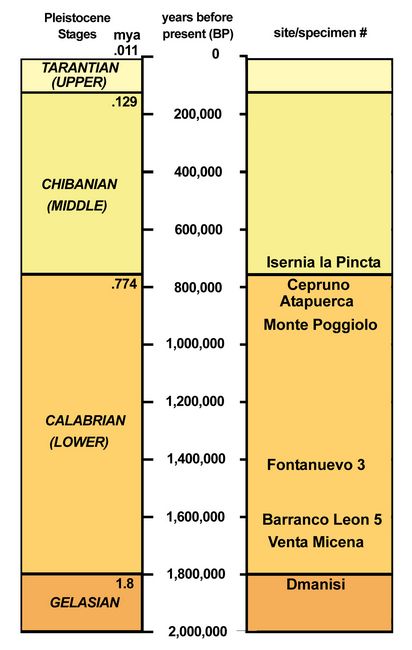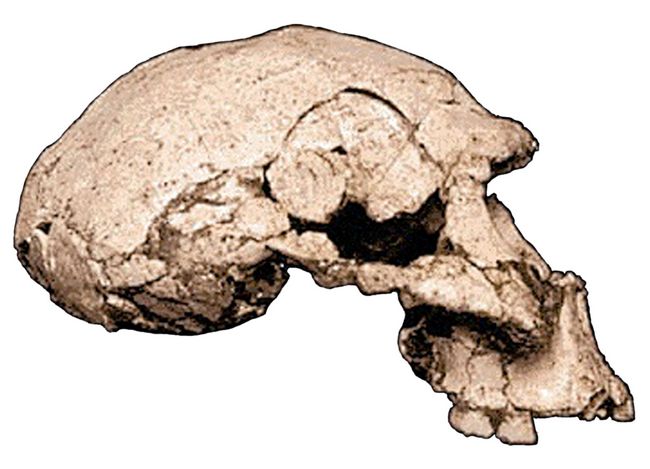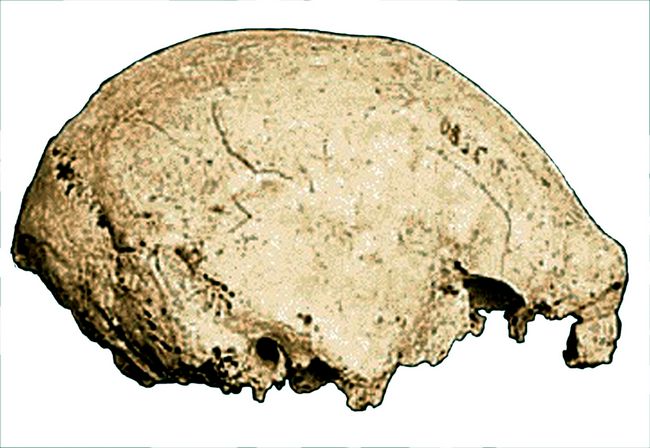Athena Review Vol. 5, no. 1
Records of Life: Fossils as Original Sources
47. Homo erectus 4: Europe
Early Migrations of Homo erectus

Current evidence shows two distinct phases of Homo erectus in Europe, with the first occurring in the Lower Pleistocene (Milliken 2004). While Dmanisi represents initial hominid migrations from northeastern Africa, another very early northwestern movement came across the Strait of Gibraltar to the Guadix-Baza basin in southeastern Spain.
Fig.1: Locations of Homo erectus sites in Europe.
During the past decade, Lower Pleistocene hominid occupations have been revealed at Barranco León-5 and Venta Micena from around 1.7 mya (with fragmentary hominid skeletal remains), and at Fuentenueva-3 from1.6-1.4 mya. Faunal remains and lithic artifacts at these sites suggest positive correlations between the activities of large carnivores such as sabre-tooth cats, and hominid scavenging subsistence using Mode I stone tools.

After a hiatus of at least 500,000 years came a second phase of Homo erectus in Europe (0.9 -0.6 mya), corresponding with the transition from Lower to Middle Pleistocene. Evidence at several sites in Spain (Atapuerca) and Italy (Monte Poggiolo, Isernia la Pineta, and Ceprano) is slightly earlier than, or contemporary with that of Chinese Homo erectus populations at Lantian and the earlier occupations at Zhoukoudian, Nanjing, and Hexian. During the second European phase Homo erectus retained Asiatic, Oldowan tool traditions, probably related to scavenging subsistence modes. In Italy, tool-making episodes at Monte Poggiolo predating 780,000 BP are evidenced by thousands of chert flakes, while at Isernia la Pineta (730,000 BP), abundant bones including those of elephants and bison were defleshed by simple, unretouched flakes. At Atapuerca in northern Spain, bones of deer, boars, and hominids were broken with stone tools for marrow extraction, indicating that by ca. 750,000 BP cannibalism was part of the local diet.
Fig.2: Time line of Homo erectus sites in Europe, correlated with Pleistocene stages
The end of the later European phase coincides with the advent of Homo heidelbergensis and the introduction of Acheulean, Mode 2 stone tools (fig.3) into Europe by about 600,000-500,000 BP. With this came more efficient subsistence practices relating to hunting and gathering. This correlates with a dramatic increase in occupation sites in Europe, which begin to be found as far north as the English Channel (as at Saint-Acheul, France, type site for the Acheulean handaxe), indicating significant population growth and expansion of adaptive ranges in Homo groups by 500,000 BP.
Fig.3: Acheulean handaxes from the River Somme valley in northern France, illustrating Mode 2 tools (Museé de Picardie, Amiens; photo: Athena Review).
Georgia: Dmanisi
The initial spread of Homo erectus from Africa occurred by about 1.8 mya to Eurasia as well as the Sunda shelf region of Java. The discoveries at Dmanisi, Republic of Georgia, of several relatively small-brained hominid remains together with Oldowan tools (Lordikipandze et al 2014; Gabunia and Vekua 1995; Gabunia et al. 2000) adds to the argument against any significant time gap between emergence of Homo and large-scale hominid migrations.

The primitive Homo erectus georgicus from Dmanisi, Georgia, dating from 1.8 mya, was discovered in the early 2000s (Lordikipandze et al. 2013). Based on a large sample size with five skulls, this taxa shows several similarities with Homo habilis, and is clearly associated with an Oldowan flake tool industry, and a faunal assemblage from the Early Pleistocene.
Fig.3: Homo erectus georgicus Skull 2 (D-2282) from Dmanisi (photo: courtesy David Lordkipanidze).
In 1984 the Dmanisi Pleistocene deposits yielded their first evidence of stone tools. Subsequent excavations by Georgian and German archaeologists led to the discovery of early hominid remains, associated with both Oldowan (Mode 1) stone tools, and 29 species of Villefranchian fauna from the Late Villanian and Early Biharian Mammal Ages, dating from 2.0 to 1.5 mya..

Two small adult or sub-adult hominid skulls with endocranial volumes below 800 cc were discovered in 1999. The smaller, Skull 2 (D-2282; fig.3), thought to represent an adolescent female, includes parts of the maxilla and a cranial vault with a capacity of about 650 cc. The larger skull 1 (D-2280; fig.4) a nearly compete calvaria with a braincase of 775 cc, has more robust brow ridges and probably represented an adult male.
Fig.4: Homo erectus georgicus Skull 1 (D-2280) from Dmanisi (photo: courtesy David Lordkipanidze).
Skull 3 (D-2700), found in 2001 (fig.5), represents a young individual, with a cranial capacity of 600 cc. Its morphology is generally gracile, but the upper canine teeth have large crowns and massive roots, making making its sex determiniation difficult. A handful of traits suggests an interpretation as male.

Skull 4 (D-3444) found in 2002 is from an elderly individual, interpreted as a male, that had lost all but one tooth. Skull 5 (D-4500), found in 2005, representing an adult, is the first completely preserved Early Pleistocene adult hominid skull found. It is identfied as a male on account of its massive and prominent cranial features. Four of the five skulls (except for D-2800) have associated mandibles, providing comprehensive inforation on tooth size and morphology.
These findings have transformed Dmanisi into a site of major importance. By 2005, Dmanisi had already produced over twenty fossilized remains of Lower Pleistocene hominids, including five skulls, associated lower jaws with intact teeth, and postcranial parts including leg, arm, and finger bones or metatarsals (Vekua et al. 2002). While stature approaches that of Homo erectus, brain size is relatively small, at times near the upper range of Homo habilis or even australopithecines.The Dmanisi skulls includes individuals with the smallest brain capacity of known Pleistocene hominins (about 600 cc), with others ranging up to about 775 cc.
Fig.5: Homo erectus georgicus Skull 3 (D-2700) fron Dmanisi.
At first assigned to Homo ergaster, Dmanisi hominid fossils were later reclassified as a subspecies of Homo erectus, called Homo erectus georgicus. Rightmire, Lordkipanidze and Vekua (2006) interpreted that if some of the more primitive, H. habilis-like traits, such as the size, cranial capacity, and parts of the facial morphology, were considered as primitive retentions or convergences (plesiomorphs), Dmanisi Skulls 1 to 4 should be classed as H. erectus. They proposed that the Dmanisi hominins represented an early subspecies of H. erectus, which they named H.E.georgicus. Subsequently, some researchers, including Lordikipandze et al. (2013), have proposed that all contemporary groups of early Homo in Africa, including H. habilis and H. rudolfensis, are the same species and should be assigned to H. erectus.
The site chronology at Dmanisi has been determined by the K-Ar date of the Mashavera Basalt underlying the fossils at 1.85 mya, while an upper date of 1.8-1.6 mya is based on volcanic ash dating and faunal analysis. Given the presence of more Palearctic than Paleotropical species, the Lower Pleistocene site, located near the confluence of two rivers, had a moderately dry Mediterranean climate.

Primitive flake and core tools found at Dmanisi, identified as an Oldowan or Mode 1 lithic industry, were made from alluvial cobbles of silicified volcanic tuffs and quartz, found along terraces of the Mashavera and Phinezauri Rivers. Cores fashioned from cobbles or cobble fragments (fig.6) sometimes show rough striking platforms, with smaller pebble tools resembling the cores. Use wear appears on flake edges as small notches or splinterings, with occasional edge retouch or sharpening, including a burin made from a large flake.
Discoveries at Dmanisi of Mode 1 tools associated with early hominids indicate that the causes of far-ranging migrations before 1.6 mya relate more to enhanced mobility and ecological adaptations, than to any sophistication of stone tool manufacture and related cognitive abilities. In the view of David Lordkipanidze, Deputy Director of the Georgian State Museum (pers. comm.), “the Dmanisi finds invalidate the theory that the development of advanced stone tool technology enabled early humans to finally expand out of Africa.”
Fig.6: Stone tools of Oldowan (Mode 1) type from Dmanisi (courtesy David Lordkipanidze).
Spain: Orce region
Three sites in the Orce region of Granada include Venta Micena, Fontenueva, and Barranco Leon. Human remains ahve been found at two of the sites, which have yielded hundreds of flake tools and debitage from an Oldowan inddustry, and animal bones showing cuts and butchering marks.
Barranco León is a site located in Granada in southeastern Spain, dating from 1.2 -1.4 mya. Here was found a tooth called "Niño de Orce", a milk tooth of a boy or girl of 10 years The site was excavated in 1995 by Josep Gibert i Clols and between 1999 and 2000 by Martínez Fernández y Toro. The type of lithic industry found consists on 150 pieces of lithic flake and flint from the Mode 1, or Oldowan technology.
Among the large mammals was found Hippopotamus antiquus, Equus altidens, Felidae cf. Homotherium sp., Megaloceros sp. and Bovini gen. et indet.[3]
References
Rightmire, GP. D. Lordkipanidze, nad A. Vekua, (2006. Anatomical descriptions, comparative studies and evolutionary significance of the hominin skulls from Dmanisi, Republic of Georgia. Journal of Human Evolution. 50 (2): 115–141.
Casado Rodríguez, Aroa (2015). Grado en arqueología. Estudio de la distribución espacial del yacimiento arqueológico de Barranco León (Orce, Granada) (PDF) (in Spanish). Universidad de Barcelona. p. 9. Retrieved 24 January 2019.
"Barranco León: Yacimiento Paleontológico". Portal de la comarca de Huescar (in Spanish). 2009. Retrieved 23 January 2019.
Toro Moyano, Isidro; Agustí i Ballester, Jordi; Turq, Alain; Martínez Navarro, Bienvenido; Oriol Oms Llobet, Josep (2000). "Los yacimientos del Pleistoceno inferior de Barranco León y Fuente Nueva 3 de Orce (Granada). Contribución al conocimiento del primer poblamiento humano de Europa". SPAL. Revista de Prehistoria y Arqueología de la Universidad de Sevilla. 9 (9): 179–188. doi:10.12795/spal.2000.i9.09. ISSN 1133-4525.
"AND331:Yacimiento paleontológico de Barranco León-5". Instituto Geológico y Minero de España (IGME) (in Spanish). Retrieved 24 January 2019.
Categories: Prehistoric sites in SpainRuins in SpainPleistocene paleontological sites of Europe)
Abatte, E.A., et al., 1998. “A one-million-year-old Homo cranium from the Danakil (Afar) depression of Eritrea. Nature 393: 458-460.
Antón, S.C., 1999. “Cranial growth in Homo erectus: How credible are the Ngandong juveniles?” Amer. Journal of Physical Anthropology 108: 223-236.
Antón, S.C., 2002. “Evolutionary significance of cranial variation in Asian Homo erectus.” Amer. Journal of Physical Anthropology 118: 301-323.
Arambourg, C. 1957. “Récentes décovertes de paléontologie humaine réalisées en Afrique du Nord française.” In Livingstone (ed.) Proceedings of the Third Pan-African Congress on Prehistory.
Asfaw, B., W.H. Gilbert, Y. Beyene, W.K. Hart, P.R. Renne, G.WoldeGabriel, E.S. Vrba, and T.D. White.2002. “Remains of Homo erectus from Bouri, Middle Awash, Ethiopia.” Nature 416: 317-320.
Binford, L.R. and C.K. Ho. 1985. “Taphonomy at a distance: Zhoukoudian, ‘the cave home of Beijing man?’”Current Anthropology 26:413-42.
Binford, L.R. and N.M. Stone 1986. “Zhoukoudian: A closer look.” Current Anthropology 27:453-75.
Boaz, N.T. and R.L. Ciochon. 2004. Dragon Bone Hill. Oxford, Oxford University Press.
Boaz, N.T. and F. C. Howell. 1977. “A gracile hominid cranium from Upper Member G of the Shungura Formation, Ethiopia.” Amer. Jour. Physical Anthropology 46: 93-108.
Boaz, N.T. et al. 2000. “Large mammalian carnivores as a taphonomic factor in the bone accumulation at Zhoukoudian.” Acta Anthrop. Sinica, Suppl.19:224-34.
Breuil, H. 1939. “Bone and antler industry of the Choukoutien Sinanthropus site.” Palaeontologica Sinica117:1-93.
Brunet, M., et al. 2002. “A new Hominid from the Upper Miocene of Chad, Central Africa.” Nature 418:145-151.
Cachel, S. and J.W.K. Harris. 1998. “The Lifeways of Homo erectus Inferred from Archaeology and Evolutionary Ecology: A Perspective from East Africa.” In M.D. Petraglia & R. Korisettar (eds.) Early Human Behaviour in Global Context. The Rise and Diversity of the Lower Palaeolithic Record, pp.108-132.
Cann, R.L., M. Stoneking, and A.C. Wilson 1987. “Mitochondrial DNA evolution and human evolution.” Nature 325:31-36.
Ciochon, R.L. et al. 1996. “Dated co-occurrence of Homo erectus and Gigantopithecus from Tham Khuyen Cave, Vietnam.” Proc.National Acad. of Sciences, USA 93:3016-20.
Clark, R.J, F.C. Howell, and C.K. Brain. 1970. More evidence of an advanced Hominid at Swatrkrans.” Nature 2254: pp.1219-1222.
Cronin, J.E. et al. 1981. “Tempo and mode in hominid evolution.” Nature 292:113-122.
Daniel, G.I. 1950. A Hundred Years of Archaeology. London, Duckworth.
Dubois, Eugene. 1894. Pithecanthropus erectus. Eine menschenaehnliche Uebergangsform aus Java. Batavia, Landsdrukkerij.
Dubois, Eugene. 1896. “On Pithecanthropus erectus, a transitional form between man and the apes.” Trans.Royal Dublin Soc., ser.2, vol.6, pp. 1-18.
Eldredge, N. and S.J. Gould 1972. “Punctuated equilibrium: an alternative to phyletic gradualism.” In Schopf T.J.M. (ed.) Models in Palaeobiology. San Francisco, Freeman, pp. 82-115.
Etler, D. 1996. “The Fossil Evidence for Human Evolution in Asia.” Annual Rev. Anthro. 25:275-301.
Foley, R. 2001. “In the Shadow of the Modern Synthesis?” Evolutionary Anthropology 10:5-14.
Gabunia L. and A. Vekua 1995. “A Plio-Pleistocene hominid from Dmanisi, East Georgia, Caucasus.” Nature.373:509-512
Gabunia, L., A. Vekua, D. Lordkipanidze, C. Swisher III, R. Ferring, A. Justus, M. Nioradze. M. Tvalchrelidze, S. Antón, G. Bosinski, O. Joris, M-A.-de Lumley, G. Majsuradze, A. Mouskhelishvili 2000. “Early Pleistocene Hominid Cranial Remains from Dmanisi, Republic of Georgia: Taxonomy, Geological Setting and Age.” Science 288:1019-1025.
Groves, C.P, and V. Mazak 1975. “An Approach to the Taxonomy of the Hominidae: Gracile Villafrancian hominids of Africa. Casopis Mineral Geolo. 20:225-247.
Haeckel, E. 1892 (orig.1868). The History of Creation. (4th Eng. ed.) London, Kegan Paul, Trench, Trubner & Co.
Hou, Y. et al. 2000. “Mid-Pleistocene Acheulean-like Stone Technology of the Bose Basin, South China.” Science 287: 1622-1626.
Howells, W.W. 1981. “Homo erectus in human descent: ideas and problems.” in B.A. Sigmon & J.S. Cybulski (eds) Homo erectus: Papers in Honor of Davidson Black, pp. 63-86. Toronto, Univ. of Toronto Press.
Huffman, O.F. 2001. “Geologic context and age of the Perning/Mojokerto Homo erectus, East Java.” J.of Human Evolution 40:353-62.
Huxley, T. H. 1863. “On Some Fossil Remains of Man,” in Evidence as to Man’s Place in Nature. London, Williams and Norgate.
Jacob, T. 1973. “Palaoanthropological discoveries in Indonesia with special reference to the finds of the last two decades.” J. of Human Evolution 2:473-85.
Jacob, T. 1981. “Solo Man and Peking Man.” in B.A. Sigmon & J.S. Cybulski (eds.), op. cit., pp.87-104.
Larick, R. and R.L. Ciochon 1996. “The African Emergence and dispersal of the genus Homo.” American Scientist 84:538-552.
Larick, R. et al. 2001. “Early Pleistocene 40Ar/39/Ar ages for Bapang Formation hominins, Central Java, Indonesia.” Proc. Nat. Acad. of Sciences 98:4866-71.
Leakey, L., P.V. Tobias, and J.R.N. Napier 1964. “A new species of the genus Homo from Olduvai Gorge.” Nature 202:7-9.
Lordkipanidze, D. 2003. Personal communication.
Mayr, E. 1950. “Taxonomic categories in fossil hominids.” Cold Spring Harbor Symposia on Quantitative Biology 15:109-118.
Mayr, E. 1963. “The taxonomic evaluation of fossil hominids.” In S.L. Washburn (ed.) Classification and Human Evolution. Chicago, Aldine.
Morwood, M. et al. 1998. “Fission-track ages of stone tools and fossils on the east Indonesian island of Flores.” Nature 392: 173-176.
Oppennoorth, W.E.F. 1932. “Homo (Javanthropus) soloensis: Een pleistocene mensch van Java.” Wetenschappelijke medeligen Dienst van den Mijnbrouw in Nederlandsch-Indië 20:49-63.
Rightmire, G.P. 1990. The Evolution of Homo erectus: Comparative Anatomical Studies of an Extinct Human Species. Cambridge, Cambridge Univ. Press.
Shipman, P. 2001. The Man Who Found the Missing Link. New York, Simon & Schuster.
Swisher, CC., G.H. Curtis, Y. Jacob, A.G. Getty, A. Suprojo, Widiasmoro. 1994. “Age of the earliest known hominids in Java, Indonesia. Science 263:1118-1121.
Swisher C.C., W.J. Rink, H.P. Schwarcz, and S.C. Antón 1997. “Dating the Ngandong Humans.” Science 276: 1575-1576.
Swisher, C.C., G.H. Curtis, and R. Lewin. 2000. Java Man. New York, Scribner.
Tattersall, I. 1995. The Fossil Trail: How We Know What We Think We Know about Human Evolution. New York, Oxford University Press.
Tattersall, I. 2000. “Paleoanthropology: the last half-century.” Evolutionary Anthropology 9:2-16.
Tattersall, I. and G.J. Sawyer. 1996. “The Skull of Sinanthropus from Zhoukoudian, China: A New Reconstruction.” Jour. Human Evolution.
Vekua, A., D. Lordkipanidze, G.P. Rightmire, J. Agusti, R. Ferring, G. Maisuradze, A. Mouskhelishvili, M. Nioradze, M. Ponce de Leon, M. Tappen, M. Tvalchrelidze, C. Zollikofer 2002. “A New Skull of Early Homo from Dmanisi, Georgia.” Science 297: 85-89.
Von Koenigswald, G.H.R. 1956. Meeting Prehistoric Man. Thames and Hudson.
Von Koenigswald, G.H.R and F. Weidenreich 1939. “The relationship between Pithecanthropus and Sinanthropus.” Nature 144: 926-929
Walker, A. 1981. “The Koobi Fora hominids and their bearing on the origins of the genus Homo.” In B.A. Sigmon & J.S. Cybulski (eds.) Homo erectus: Papers in Honor of Davidson Black, pp.193-216. Univ. of Toronto Press.
Walker, A.and R. Leakey, (eds.). 1993. The Nariokotome Homo erectus skeleton. Cambridge, Harvard Univ. Press.
Wanpo., H. et al. 1995. “Early Homo and associated artefacts from Asia.” Nature 378:275-278.
Weidenreich, F. 1943. “The skull of Sinanthropus pekinensis: a comparative study on a primitive hominid skull.” Palaeontologia Sinica, New Series D 10.
Weidenreich, F. 1945. “Giant early man from Java and south China.” Anthropological Papers, American Museum of Natural History 43: 205-90.
Weiner, S. et al. 1998. “Evidence for the use of fire at Zhoukoudian, China.” Science 281: 251-53.
Wolpoff, M. and A. Thorne. 1991. “The case against Eve.” New Scientist, June 22, 1991: pp.37-41.
Wood, B. and M. Collard 1999. “The Human Genus.” Science 284:65-71.
Zhu, R. et al. 2001. “Earliest presence of humans in Northeast Asia. Nature 413: 413-417Holloway, Ralph 1982
Leakey, M. D. 1971 Olduvai Gorge: Volume 3, Excavations in Beds I and II, 1960-1963. Cambridge University Press.
Lepre, C. J. and D.V. Kent, 2010. New magnetostratigraphy for the Olduvai Subchron in the Koobi Fora Formation, northwest Kenya, with implications for early Homo. Earth and Planetary Science Letters. 290 (3–4): 362
Lepre, C. J.; H. Roche, D.V Kent, et al. 2011. An earlier origin for the Achuelian . Nature. 477 (7362): 82–85.
Lordkipanidze, D. M.S. Ponce de Leòn, A. Margvelashvili, Y. Rak, G. P. Rightmire, A. Vekua, C. P.E. Zollikofer 2013. A Complete Skull from Dmanisi, Georgia, and the Evolutionary Biology of Early Homo. Science. 342 (6156):
Shipman, Pat 2002. The Man who Found the Missing Link. Eugène Dubois and His Lifelong Quest to Prove Darwin Right, Harvard University Press.
von Koenigswald
Weidenreich, F. 1935 . The Sinanthropus Population of Choukoutien (Locality 1) with a Preliminary Report on New Discoveries . Bulletin of the Geological Society of China. 14 (4):
Wu et al. 2010
Glossary